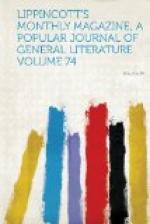The breakfast was half German, half Turkish. Here is the bill of fare: Oysters on the shell from the Bosphorus—the smallest variety I have ever seen, very dark-looking, without much flavor; fried goldfish; a sort of curry of rice and mutton, without which no Turkish meal would be complete; cauliflower fritters seasoned with cheese; mutton croquettes and salad; fruit, confectionery and coffee. With a young housekeeper’s pride, Madame A—— took me over her house, which was furnished in European style, with an occasional touch of Orientalism. In the centre of the reception-room was a low brass tripod on which rested a covered brass dish about the size of a large punch-bowl. In cold weather this is filled with charcoal to warm the room. “Cold comfort,” I should think, when the snow falls, as it sometimes does in Constantinople, and the fierce, cold winds sweep down the Bosphorus from the Black Sea and the Russian steppes. As in all the best houses in Pera, there were bow-windows in the principal rooms of each story. A large divan quite fills each window, and there the Greek and Armenian ladies lean back on their cushions, smoke their cigarettes and have a good view up and down the street. There was a pretty music-room with cabinet piano and harp, and opening from that the loveliest little winter garden. The bow-window was filled with plants, and orange trees and other shrubs were arranged in large pots along the side of the room. The wall at one end was made of rock-work, and in the crevices were planted vines, ferns and mosses. Tiny jets of water near the ceiling kept the top moist, and dripped and trickled down over the rocks and plants till they reached the pebbly basin below. The floor was paved with pebbles—white, gray, black and a dark-red color—laid in cement in pretty patterns, and in the centre was a fountain whose spray reached the glass roof overhead. There were fish in the wide basin around the fountain, which was edged with a broad border of lycopodium. A little balcony opening out of an upper room was covered with vines, and close to the balustrade were boxes filled with plants in full bloom.
[Illustration: THE SULTAN’S NEW PALACE ON THE BOSPHORUS.]
But the housetop was my especial admiration. It was flat, with a stone floor and high parapet. On all four sides close to this were wide, deep boxes where large plants and shrubs were growing luxuriantly. Large vases filled with vines and exotics were placed at intervals along the top of the parapet. Part of the roof was covered with a light wooden awning, and a dumb-waiter connected with the kitchen, so that on warm evenings dinner was easily served in the cool fresh air of the roof. The view from here was magnificent—the Golden Horn, Stamboul with its mosques and white minarets, and beyond the Sea of Marmora. Where a woman’s life is so much spent in the house, such a place for air and exercise is much to be prized, but I fear my pretty Austrian friend will sigh for the freedom of Vienna after the novelty of the East has worn off.




